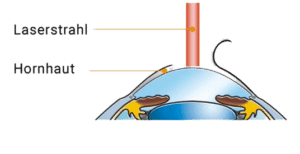LASIK – See the world in a new light
Experience the freedom of glasses and contact lenses. LASIK offers you the opportunity to improve your vision sustainably. Trust in modern technology and Dr. Steinhorst's many years of experience for a result that will exceed your expectations.
Benefits of LASIK treatment
Short operation time of only 60 seconds
Long-term and permanent vision correction
Fast recovery and minimal downtime
NASA-tested for precise results
millions of successful operations worldwide
No need for glasses or contact lenses
Pain-free during the procedure
possibility of subsequent correction
Voraussetzungen für eine erfolgreiche LASIK
- The prescription should have been stable for at least 1 year.
- The minimum age is 18 years.
- There should be no progressive retinal diseases
present. - No procedure should be performed during pregnancy or breastfeeding.
What does LASIK mean?
LASIK (laser in situ keratomileusis) is a laser eye procedure used to correct vision problems. It uses an excimer laser to change the shape of the cornea. The goal is to adjust the eye so that light rays are focused precisely on the retina, resulting in clear vision. LASIK is the popular choice for people who want to reduce their dependence on glasses or contact lenses. The treatment is usually quick, recovery time is short, and it offers a permanent solution to various types of vision problems.
What can be corrected with the LASIK procedure?
The LASIK procedure is an effective method for correcting various visual impairments, but with certain limitations:
Nearsightedness (myopia): LASIK can be successful for myopia up to -10 diopters (dpt).
Farsightedness (hyperopia): In cases of hyperopia, LASIK can be effective up to a degree of +4 dpt.
Astigmatism (curvature of the cornea): LASIK can correct astigmatism up to 6 dpt.
It is important to note that an individual's suitability for LASIK treatment depends on other factors, such as the thickness and shape of the cornea, the specific degree of visual impairment, and overall eye health. An ophthalmologist can determine whether LASIK is the right treatment for an individual through a comprehensive examination using appropriate diagnostic equipment.
5 advantages of the LASIK procedure
1. Painless and time-efficient treatment
The procedure only takes a few minutes and is painless thanks to the local anesthesia.
2. Outpatient implementation
LASIK is usually performed on an outpatient basis, meaning you can go home immediately after the operation.
3. Rapid improvement of vision
You will have good vision after just a few hours. You can largely resume your normal daily life the next day.
4. Gentle and fast healing process
The natural structure of the superficial corneal layers is preserved and the healing process is without complications.
5. Reliable and recognized worldwide
Through LASIK treatment, more than 17 million people worldwide have been operated on with outstanding treatment results and have successfully freed themselves from glasses and contact lenses. This method is considered reliable worldwide and enables an improved quality of life through clear and independent vision.
Alternatives to LASIK
The Trans-PRK and Femto-LASIK are both advanced alternatives to the classic LASIK method. Trans-PRK (transepithelial photorefractive keratectomy) is a non-contact procedure in which the top layer of the cornea is removed with a laser, ideal for patients with thinner corneas. Femto-LASIK, on the other hand, uses a femtosecond laser to create a precise corneal flap and offers rapid healing and high precision, particularly suitable for complex vision defects. Both methods offer innovative, safe alternatives for individual vision correction.
How does LASIK work?
Step 1: Preparation of the corneal disk (flap)
First, a thin slice of the cornea, approximately 0.12 mm thick, is prepared using a computer. This process is carried out with extreme precision to ensure precise control over the thickness and shape of the flap. The flap can be prepared using a keratome or with an additional laser - the FEMTO second laser.
Step 1: Preparation of the corneal disk (flap)
After preparation, the corneal disc is carefully folded back like a book cover. This allows access to the underlying deeper layer of the cornea, which is responsible for correcting vision. The corneal layer is then precisely modeled using a specialized laser. The laser specifically removes corneal tissue in order to change the curvature of the cornea according to the necessary vision correction.
My surgery day: LASK surgery procedure
On the day of LASIK surgery
Be sure to arrive at the laser center on time - that is, at least 15 minutes before your appointment. You will be given a sedative and a painkiller if you wish. The eye is numbed with drops; there are no injections. The laser operation is painless. In the first few hours after the LASIK operation, you will only feel a foreign body sensation with scratching, your eye will water and your vision will be blurred. After 2-3 hours, you will be free of symptoms.
How long does the operation take?
The surgical procedure itself only takes a few minutes. Including pre- and post-operative examinations, you should expect it to take around 1 to 1.5 hours. Shortly after the operation, you can relax in our relaxation room.
What you should know:
Almost normal vision is usually achieved the day after LASIK. During the first few nights, you will wear special plastic contact lenses that we provide to protect your eyes. You will also take various eye drops, which you should use exactly as instructed during the first week. If you experience severe pain or a sudden deterioration in your vision, call us immediately.
After LASIK surgery
In the first few weeks there will be slight changes in vision, final stability is achieved after about 3-4 weeks.
Basically, the less visual impairment you have before LASIK, the greater the chance that you will no longer need distance glasses after the operation. Even with optimal results - i.e. no distance glasses - you can expect to need reading glasses from around the age of 50, although everyone with normal vision needs them from this age onwards.
Minimize stress:
- Do not rub or press on the eye
- Wear a sleep mask at night for a week
- No heavy physical activity (>20 kg) for 2 weeks
- Avoid swimming, sauna and gardening for 2 weeks
- TV and screen work possible after 1-2 days, with breaks
- Protect your eyes from bright light and sun (wear sunglasses for 2 weeks)
Eye drops:
- Application according to plan (drip scheme)
- Use artificial tears regularly for 3-6 months
Washing hair & applying make-up:
- Generally allowed, but make sure that no water, soap or shampoo gets into the eyes during the first week
- Powder/eye shadow is allowed 3 days after surgery
- No waterproof makeup for 2 weeks
Sport:
- Light sports (jogging, Pilates) after 1 week
- Weight training after 14 days, swimming and sauna after 2 weeks with protective goggles

The way to life without glasses with LASIK
Femto-LASIK is considered the gold standard in refractive eye surgery and is known for its exceptional precision in correcting refractive errors such as nearsightedness, farsightedness and astigmatism. This method enables a correction accuracy of up to 1/100 diopter. This method combines the advantages of LASIK with the advanced technology of the femtosecond laser, which enables a tailor-made, precise treatment for each individual eye.
As an experienced chief physician at the LZW and expert in Femto-LASIK, Beate Steinhorst will be happy to advise you comprehensively on this topic.
LASIK at LZW: fast, safe, gentle
You are currently viewing a placeholder content of YouTube. To access the actual content, click on the button below. Please note that this involves sharing data with third parties.
More informationLASIK opens up a new attitude to life: freedom without glasses and contact lenses. The LASIK treatment only takes a few minutes and is painless.
Glasses or contact lenses limit many people in their daily lives: Visual aids are not permitted at work, for example for safety reasons, and they are simply a hindrance in many sports, such as swimming. Many contact lens wearers suffer from dry eyes due to air conditioning, and people who wear glasses suffer from headaches due to glasses that do not fit properly. Lost contact lenses and broken glasses are also simply annoying.
LASIK provides relief: As one of the best-known and safest methods of correcting visual impairments, such as nearsightedness or farsightedness, several million people worldwide have already undergone LASIK.
Overview of visual impairments
In the case of a visual impairment, the light rays or pixels entering the eye are not focused exactly at one point on the retina as they are in a “normal-sighted” eye. The result is a blurred or distorted image, as the ratio of the length of the eye to the curvature of the cornea is usually not correct. In principle, the eye can be compared to a camera: the cornea and lens correspond to the lens, the retina corresponds to the film.
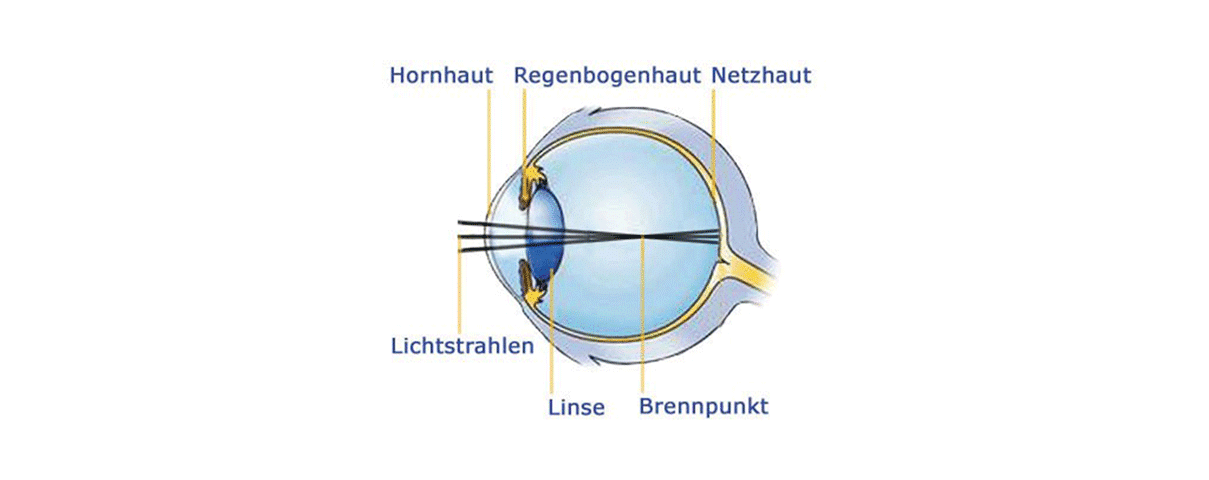
nearsightedness (myopia)
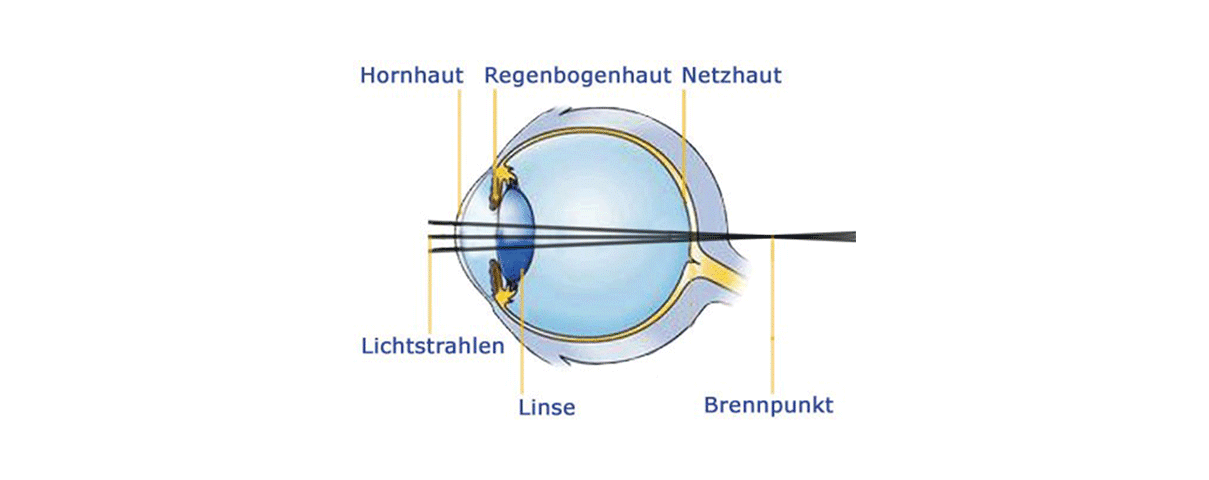
farsightedness (hyperopia)
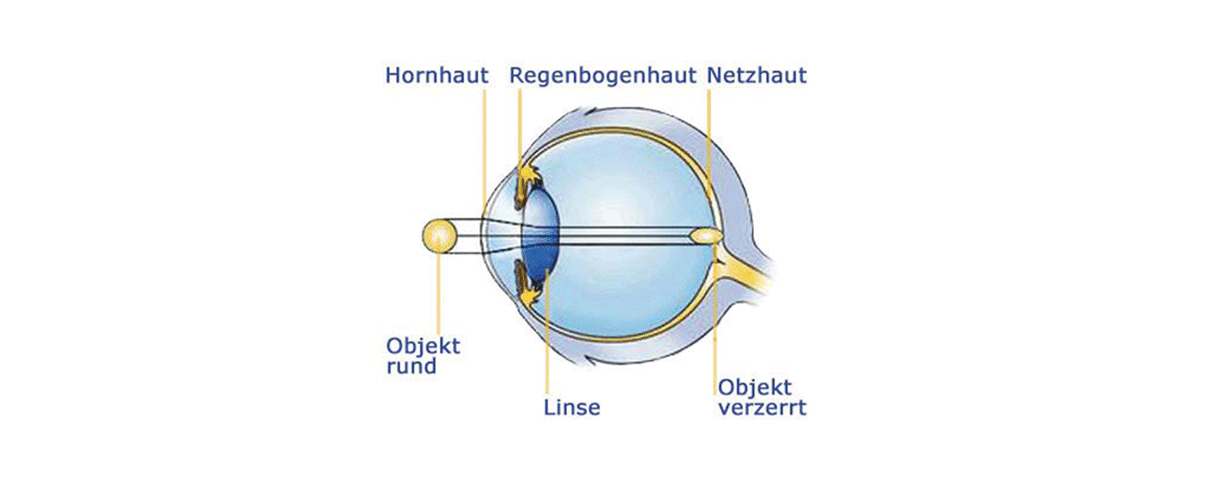
astigmatism
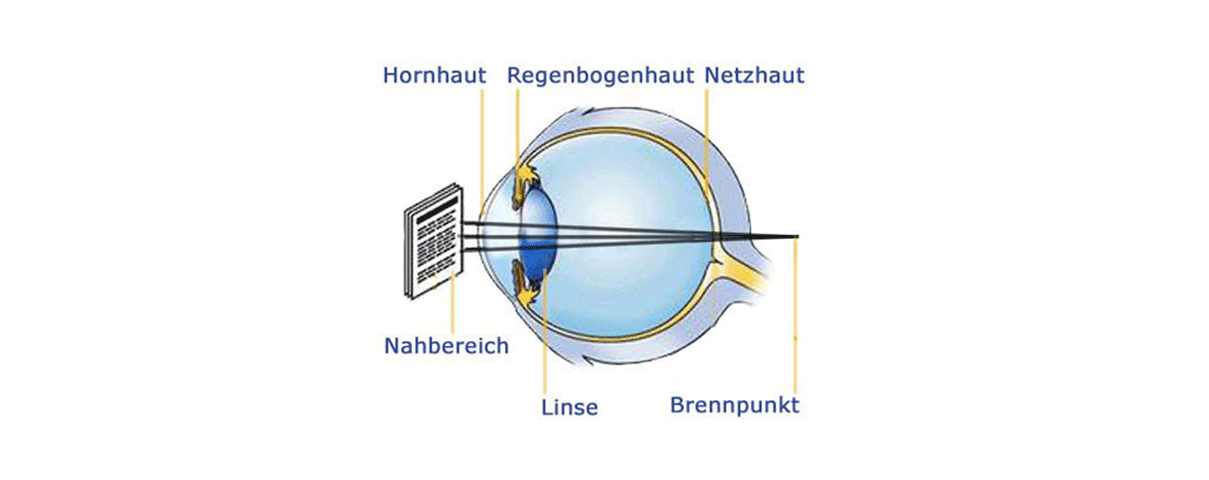
presbyopia
Many people with normal vision need reading glasses from around the age of 50. The reason: the lens of the eye loses more and more elasticity and can bend less and less. When this ability is no longer sufficient, one's vision at reading distance is blurred. One may hold a text a little further away or reach for reading glasses. However, this natural aging process does not compensate for the short-sightedness of a young adult. If someone is short-sighted, they can read without glasses even in old age, but they always need distance glasses, e.g. for driving.
Eye surgeries:
Which procedure is right for you?
Are you ready to free yourself from the limitations of glasses or contact lenses? Discover the variety of lens procedures and options that fit your lifestyle with our test. Learn more about customized solutions for your eyes.
Costs for LASIK
The cost of an operation is between EUR 1,000 and EUR 2,150 per eye, depending on the procedure. This, as well as all costs for pre- and post-operative examinations, are based on the applicable fee schedule for doctors (GÖA). The differences in costs are due to the different LASIK treatment procedures, which are determined by the anatomical requirements of each eye (thin cornea/increased glare with higher-order aberrations, etc.).
reimbursement of costs by statutory health insurance companies
Reimbursement of costs by the statutory health insurance is excluded.
coverage by private health insurance companies
Private health insurance companies cover the costs of LASIK in whole or in part. It is advisable to ask your health insurance company about the exact conditions and, if necessary, submit a cost estimate.
Judgment with signal effect
According to a court ruling by the Dortmund Regional Court (AZ 2 S 17/05), private health insurance companies must cover the costs of laser eye treatments.
The court's reasoning: Laser eye treatment is a recognized scientific method of treatment that can lead to better results than correcting poor vision with glasses or contact lenses alone. According to the court, visual aids only treat the symptoms, whereas laser eye surgery addresses the root of the visual defect.
Laser eye treatment is therefore definitely a medically necessary treatment. Those with private insurance can be happy because the PKV has to cover the treatment costs. If you are a private patient, speak to your health insurance company if you are planning laser eye treatment.
Deduct eye surgery from taxes
Taxpayers can claim the costs of laser eye surgery as an extraordinary expense in their income tax return.
Make an appointment for a non-binding consultation or come to one of our free information evenings. Information at Tel. 0611-360 220
Is the laser treatment painful?
Will I be in pain after the laser treatment?
How long does the treatment take?
How long do the results of LASIK laser eye treatment last?
When can I drive, exercise or work again after surgery?
drive a car: After just 1 to 2 days, once visual acuity has stabilized.
Work: Return to work is usually possible after 1-2 days, although the use of eye drops for follow-up treatment during work is important.
to do sports: Sports activities can usually be resumed 1-2 days after treatment. However, direct contact with the cornea and vigorous rubbing of the eyes should be avoided in order not to endanger healing. These times can vary depending on the individual healing process and type of treatment.
What are the success rates for LASIK, Femto-LASIK or Trans PRK?
How well can I see after laser treatment?
Are there any risks associated with laser treatment?
Real experiences and results with LASIK
Based on authentic experiences and outstanding results, we are proud to be the best-rated laser eye clinic in Wiesbaden. Our 4.5 stars Reviews on Google speak for themselves. Together we will accompany you, step by step, on the way to a life without glasses.







